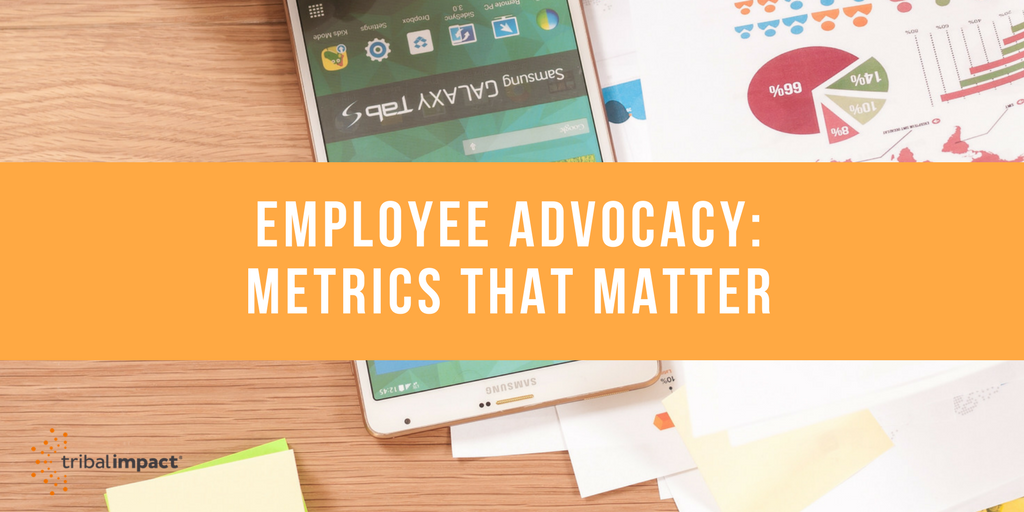Ever wondered how to truly measure the impact of social media? Do you really understand the value of your social media efforts in terms of revenue? If you can't answer these questions from a marketing context, chances are you're going to struggle when it comes to Employee Advocacy and Social Selling.
We work with customers to measure end-to-end advocacy impact. By that I mean they measure advocacy generated opportunities, lead conversion rates and pipeline influenced.
When you measure the impact within the context of business you start to identify fascinating patterns. Lead conversion is higher, deal cycles tend to be faster and deal sizes tend to larger. Not to mention that the competition are rarely in the frame at this point.

It doesn't matter where you are in Social Business journey or indeed which function you're driving the transformation from, one common factor you need to be clear about it how you measure the impact of your efforts.
Why Measure Social Advocacy Impact?
There are three core components of Employee Advocacy success - training, tools and content. If you miss one out, there's a good chance you could massively reduce your adoption levels and/or results.
In my experience the tool comes first, then the realisation that content needs to be managed (otherwise it's a big mess). Finally, training is wrapped around to reinforce the "what's in it for me" message for employees.
Simply put, if you can't measure the impact of your Employee Advocacy journey you:
- Won't know if you're achieving the objectives you set
- You'll limit your ability to adapt and tweak your program over time
- Find it hard to communicate ROI to leadership
- Struggle to secure investment to renew tool licenses next year
How To Measure Employee Advocacy Impact
The term 'vanity metrics' is often used in the world of social media when we seek to impress audiences with millions of impressions, reach and engagements. In isolation, they mean very little. Put into context, they can provide insight into what is and isn't working for you.
Many employee advocacy tools will provide you with data around usage and content. The trick is to understand the narrative and the story behind what the data is telling you.
Here are some ways to measure the impact and progression of social advocacy within your business in relation to the adoption stage you may be at:
Setting Advocacy Objectives:
At this stage you need to understand how and why you're researching Employee Advocacy. Consider wider business metrics and the impact that advocacy can have.
For example:
- Sales - Revenue generated, pipeline influenced, opportunities closed
- Internal communications - Employee engagement survey results
- Recruitment and hiring - number of new hires via employee referrals, cost of hire
- Marketing - volume of traffic to website, attribution tracking
Measuring Launch Success:
During the launch phase of your program, turn your attention to measurements that give you immediate feedback on how well your program is being adopted. It's critical that you're agile at this stage. Quick action can accelerate your success.
For example:
Adoption Metrics:
- % adoption across the organisation
- % invited employees that have registered
- % active users (logged in or shared at least once per month)
- % mobile users vs desktop users
User Metrics:
- Identify your early adopters and highlight them
- Identify your social spammers and educate them
- Identify your least active sharers and encourage them
- Average # articles shared p/week p/employee
Marketing:
Cost per click - a quick measure of success is to look at your average cost per click for paid social campaigns. For example, you can expect to pay somewhere between €3-€6 per click on LinkedIn. Multiply the number of clicks by average cost and you'll get a quick hack for cost saved/value driven via advocacy.
Optimising Your Content & Usage:
This is the stage where your advocacy program has been running for at least 6 months. Optimisation will look at users, content and training to understand which levers you need to pull/adjust in order to drive more success.
This is the stage where you get a deeper understanding of what the data is telling you. Look for patterns, correlations and comparisons e.g. understand if advocacy referred leads generate higher conversion rates from lead to MQL (Marketing Qualified Lead) and from MQL to SQL (Sales Qualified Lead).
This is also the stage where you need to pay close attention to your content. Without relevant and interesting content for your Employee Advocacy Program, employees won't participate.
Website:
- % volume traffic referred via social advocacy via UTM tracking
- % job posting views as a result of employee driven traffic
- % bounce rate of advocacy driven traffic vs other sources
- % conversion of advocacy driven traffic vs other sources
Content:
- Most shared content by category - what do your employees enjoy sharing?
- Content driving most clicks - what are your employee networks interested in reading?
- Content driving most engagements - what type of content is engaging employee networks most?
- Your most popular categories - is there a correlation between volume of content submitted to those categories and volume of content shared?
- What patterns are emerging with high performance content? Using hashtags? Mentioning influencers? How to posts? List posts?
- Is your ratio of brand/non-brand content working?
Curator Performance:
- Who is submitting the most content to the platform?
- Who is submitting the most engaged content?
- Who is submitting the most clicked content?
- Which categories need more volume? More thought leadership?
Connecting Advocacy To Revenue:
Finally, advocacy nirvana.
It's that moment when Google Analytics is talking to your marketing automation system and your automation platform is connected to your Sales CRM platform. Identify patterns and look for correlations across data.
Providing you have the tool stack connected and UTM tracking switched on, you can weave advocacy touched/influenced/generated attribution into your model.
In effect, you turn your workforce into a sales force, where potentially everyone can influence the buyer journey.
For example:
Sales:
- Won/booked sales generated via advocacy
- Correlation between SSI score and advocacy activity level
- Correlation between quota attainment and advocacy activity level
- Pipeline closure rate of advocacy generated pipeline vs other pipeline
- Number of new customers generated via advocacy
Employee Engagement:
- Employee engagement results correlated to advocacy launch
- Hiring costs saved as a result of employee referred hires
- Average employee on-boarding time of advocacy referred hires vs other hires
- Average employee engagement of advocacy referred hires vs other hires
Marketing:
- NPS (Net Promoter Score) trends against advocacy usage
- Paid social saving using Cost Per Click averages
- % conversion rate of advocacy driven leads vs other lead sources
Measuring the impact of employee advocacy needs to be considered within the wider context of your business. Look at what your business is already measuring and then seek out correlations and comparisons based on the data you get within your employee advocacy tool.
With end-to-end attribution, there is no reason why you can't get to a position where you can confidently say "X number of customers closed as a result of advocacy generating X pipeline". This is possible today if you know how to build the framework to make it happen.



